Good News Rockford!
Are we ready to grow? That takes your voice.
By Ronald Clewer
April 27, 2024
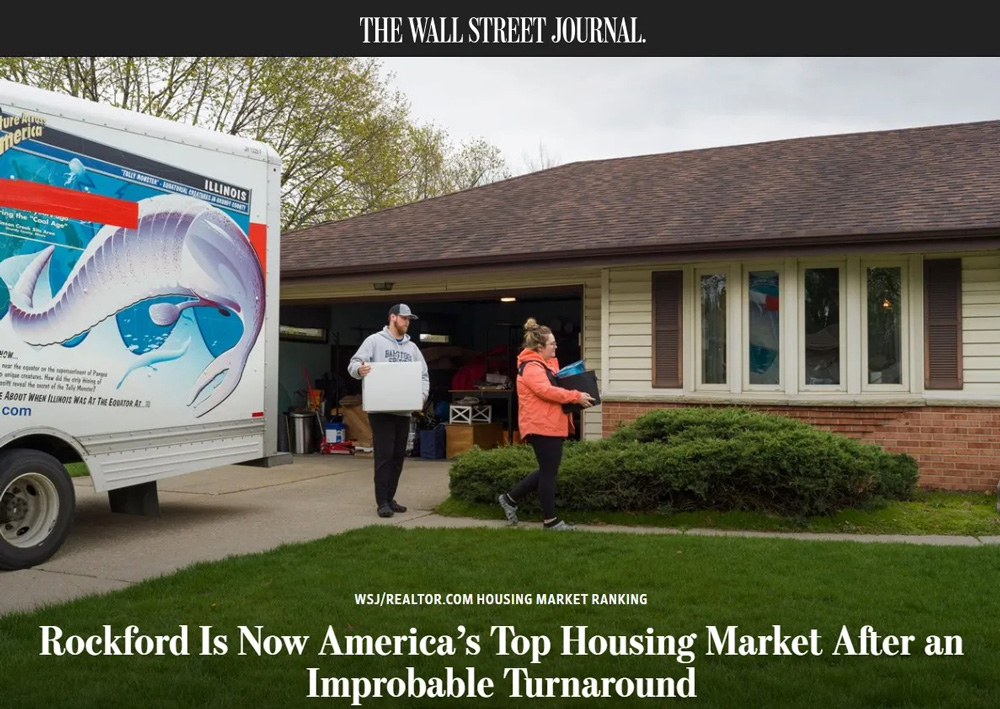
Any time we can celebrate good news, we should! This past Thursday, the Wall Street Journal and Realtor.com published an article, Rockford Is Now America’s Top Housing Market After an Improbable Turnaround. The two organizations rank metro areas according to real-estate market data, economic health, and quality of life. All the resulting high-ranking metro areas also boast considerable climate resilience. The article cites, “The median listing price in Rockford was $235,000 in March, 51.7% higher than one year prior, but still nearly $200,000 lower than the 200-metro average median. Though home prices have climbed significantly, this is in part due to an increase in for-sale home size.”
The following day, Friday, DailyMail UK published, REVEALED: The Midwestern city where Americans can still make a killing on property after prices surged 52% in a year, with plentiful skilled jobs, cute streets and lush greenery fueling country’s hottest property market. Amidst a great deal of warranted praise for our restored downtown, ability to attract entrepreneurs, nature, history, art, markets and lively restaurants and bars, the article also reminds us how relatively quickly a market can change. The article reminds us of our turnaround from the underwater mortgage capital of the nation where, a third of homes were worth less than the mortgages taken out on them.
This is the reality of real estate markets; they are subject to change. This change is often driven by the policies and practices of the market, including the actions on government. In Rockford, especially the actions of Government.
Also on Friday, the Rock River Current published, An Ongoing Issue For The Rockford-Area’s Top-Ranked Real Estate Market: Not Enough Homes On The Market by Kevin Haas. Kevin focused on this inventory issue. His article cites, “The low inventory has driven up prices in the three-county region the [Northwest Illinois Alliance of Realtors] association tracks. The average sales price in March rose nearly 19% compared to March 2023. That is an increase from $170,145 to $202,244.” Please note there is no price discrepancy between the two articles, one focuses on median listing price and the other average sale price.
While the news of being at the top of desirability in housing and having our quality of life praised is incredible, we must also act so we can hold on to such accolades and grow our community. For this reason, I am glad to see others are noticing the correlation between rising prices and low inventory.
Low inventory can only be beneficial for a short period of time and doesn’t make for a sustainable market or community. Last October, in my Substack post, I published, Housing Underproduction, and a few days later followed with Rockford IL – Housing Affordability. These two articles focused on our historic underproduction of housing and its impact on our market. That affect is affordability – for the residents who live here. Top communities ensure they are attractive to not only new but also existing residents and ensure all residents can thrive.
In that October post I noted 19.6% of our current homeowners were cost burdened, meaning they spend more than 30% of their income on housing – this was 17,769 homeowners in the metropolitan statistical area (MSA) according to the Joint Center for Housing Studies of Harvard University. Of additional concern is that our renter population is 52.2% cost burdened and 27.1% severely cost burdened – spending more than 50% of their income on rental housing costs. This is traditionally our pipeline to homeownership and these burden rates not only threaten their ability to buy a home, but simply stay in our community. While not a feature of any of our recent articles, except for historic adaptive reuse of downtown buildings, rental housing production has also been severely absent in our community.
In December of 2023 I wrote, Rockford – Now is the time to act! In this post I wrote about the state of property taxes, including the positive work the city is doing to reduce property taxes – more good news! The post also covers the risk for our market; that risk is low inventory placed us third on the list in, 10 Midwest Cities That Could Be Headed for a Housing Crisis. Inventory is a problem.
The following St. Louis Federal Reserve chart adds impact to Kevin Haas’ article on inventory. In Haas’ piece he follows inventory to 2020, a healthy state of inventory. If we look back to 2017, we see what having too much inventory looks like, also an unhealthy condition.
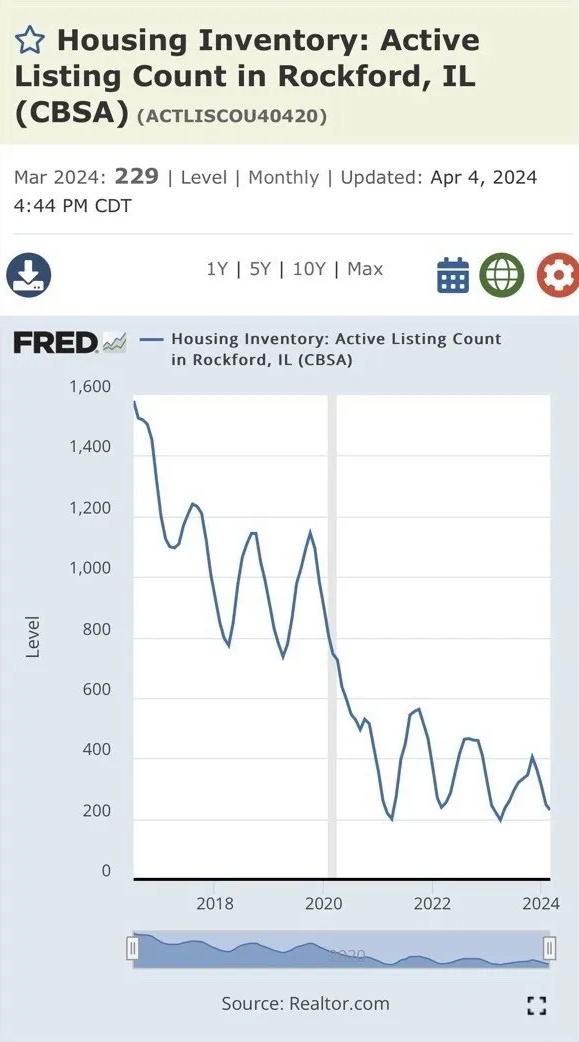
This 2017/18 excess inventory was existing home inventory as no new measurable homes were bult in Rockford – then and now. Today we continue to produce no new meaningful inventory in Rockford as is evidenced in the chart and Haas’s article; he cites nineteen new homes last year. This is my concern.
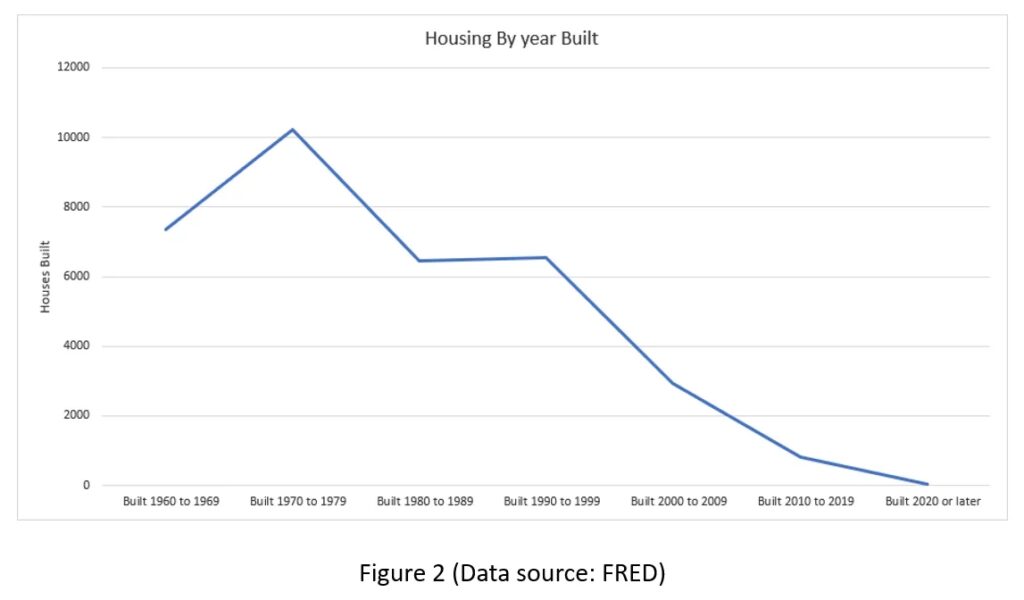
It is also worth noting that the areas surrounding Rockford, while production is still low, are producing more new housing inventory than Rockford, as is evidenced in the following Winnebago County chart.
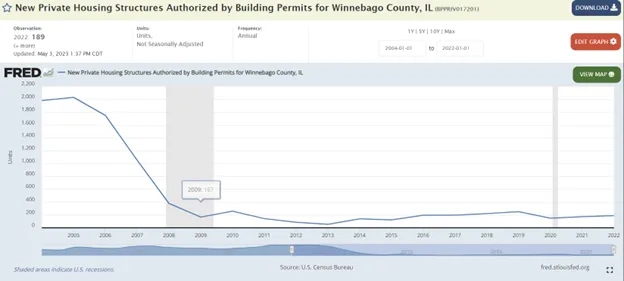
Additionally, a ride through Love’s Park shows reasonable production, almost reminiscent of the 2005 era, occurring along Harlem and McFarland roads.
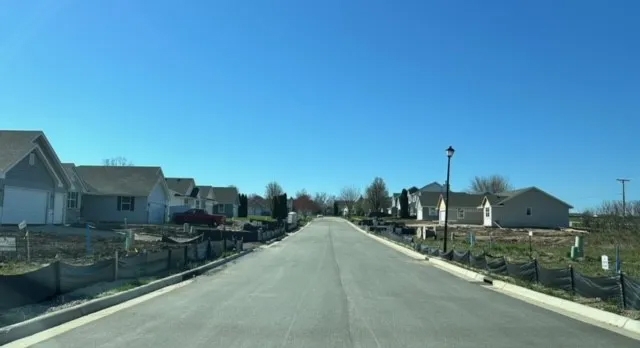
This construction on the fringe around, and not in our city, should concern all of us who call Rockford home. The excess inventory in that 2017-2018 era was caused by residents our long trend of population decline. While we have seen new residents moving to Rockford, we still have a net loss of residents.
My concern, first framed in Labor and Housing, written November of last year, is that we are on the cusp of a renaissance that has the potential to be sustainable. I want to see that. I want to see us continue to grow. With 7,000-10,000 new jobs coming to our region, will Rockford be where these new employees buy homes and settle, or will they choose the communities on our fringe? While we can say its good for the region if these new residents choose the region, the reality is if they don’t choose Rockford that threatens the continued growth of our boutique shops, restaurants, and bars along with other new businesses – those items praised in the Wall Street Journal and the UK article. Simply, Rockford needs to grow to continue to sustain our quality of life and that previously mentioned trend of declining property tax rates.
There is good news here and glimmers of hope but will pending actions pass Rockford City Council? I saw the answer to that is up to us. As Haas mentioned in his article, the City of Rockford did pass a resolution to waive single family building permits and water connection fees for those who choose to build new homes prior to December 31, 2024. This is done, but there is more on the horizon. Opportunities for us to be involved and help shape the potential of our city.
In November, I also wrote, Reforming Land Use Regulations and Housing Production, Zoning Code – A Rockford, IL Review. In this article I covered the single-family production cost increases the then new zoning code placed on a new home – an estimated $28,000 per home in today’s dollars. In May, the city will consider a resolution to exempt prior platted subdivisions from the character standards passed in that 2008 zoning code. We should call our council members to support his move. This has the potential to remove the restrictions from approximately half, or about 250 of the near five hundred currently available platted single-family lots in the city. As noted, this is a good move, but in my opinion, more needs to be done. Nonetheless, I encourage you to contact your council member today to support this work. Find your alder HERE along with their contact information. If we can pass this and a homebuilder can couple it with the permit and connection fee exemption this year, we could see a nice pop in production this 2024 building season. Again, for sustainability’s sake, more must be done.
I also encourage us to address two other pipelines towards potential inventory – tentatively platted lots and existing former single family infill lots.
The city has approximately 1,800 tentatively platted lots. These are lots where plats were filed, and the subdivision process halted because of market conditions. These subdivisions bring new challenges in that they require new infrastructure i.e., roads and utilities including expansions to city water and sewer. I believe we should considered select locations where the long-term costs do not outweigh the immediate benefits. While we need housing inventory, sprawling to get it does not necessarily provide a return and could in fact create more costs than revenue. We should encourage the city to consider these tentative plats on a case-by-case basis where ROI is the factual decision driver.
Additionally, we should encourage the city to incentivize production, in addition to the no cost permit and connection fees, to build on existing lots where homes used to be. These lots provide the best return on investment for us as a city as the infrastructure is in place; however, they also provide significant risk to builders, as example, a builder does not know if the former home was properly removed causing additional costs to remove footings or foundations. Additionally, depending on the condition of the surrounding neighborhood, the home may not be worth the cost of producing it. This can be offset by the city using pass through HOME and CDBG funding to provide down payment assistance to the buyer or directly to the builder to help “bridge” the gap.
In the case of infill, we are positioned well with the Region 1 Planning Council Land Bank to sell such lots, as is evidenced in the map below, we just need the builder incentives and perhaps a prioritized process.
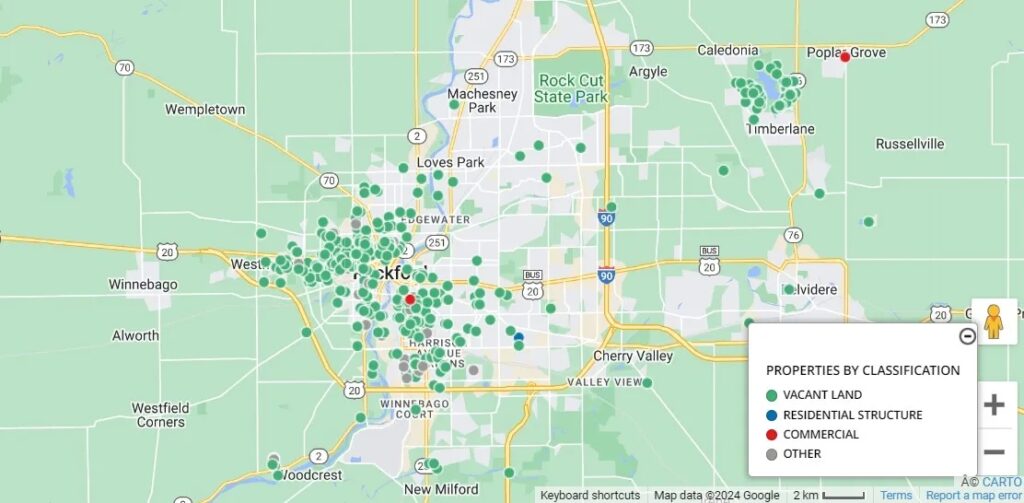
“The proliferation of vacant lots on the south and west ends of the city is an equity issue,” as stated by the City of Chicago, redresses the same issue we have here. The City of Chicago responded with the ChiBlocBuilder program. Their first step was to admit a historic role in current conditions. This is the City’s statement, “Decades of disinvestment and structural racism have led to high concentrations of City-owned vacant land on the South and West sides of Chicago. Institutions including the City of Chicago permitted the practices of urban renewal, redlining, contract buying, and the building of highways, which displaced Black and Brown communities and cut off access to resources and wealth. This has contributed to the proliferation of neighborhood blight, reduction of community safety, and hindering of neighborhood vitality.”
To accomplish this infill construction, ChiBlocBuilder is leveraging city lots, as we can do with our land bank. They also provide simplified applications for identified uses as shown below.
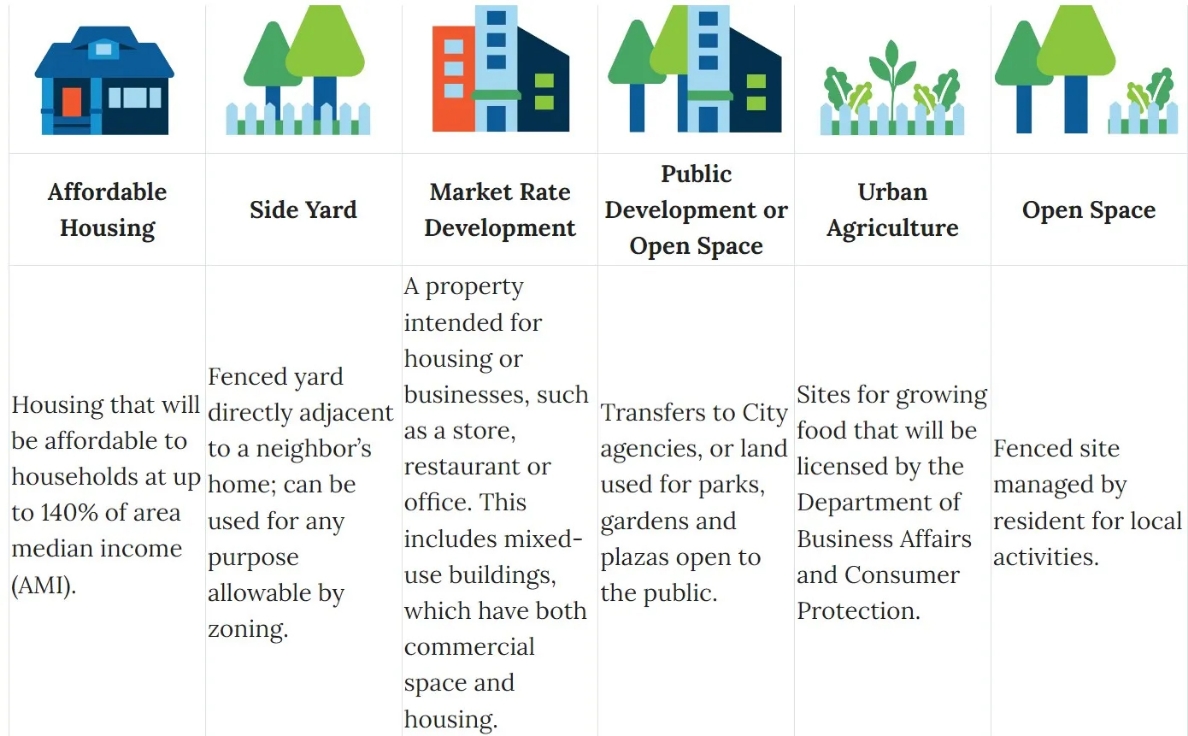
Residents, developers, community organizations, and other entities are eligible to purchase lots for use as side yards, housing, commercial projects, and open spaces such as gardens or plazas. Additionally, the city encourages land trusts to preserve affordable housing and commercial growth. The City’s Community Wealth Building model defines a community land trust as an organization governed by community owns land in perpetuity while residential and commercial tenants own the structures atop the land via a 99-year ground lease.
Where do we go from here? Can we continue this reign of desirability, or will it be short lived? When the 7,000 to 10,000 jobs show up in our region, will their guests knock on their doors in homes in Rockford, or outside our city? They say necessity is the mother of invention. I would add innovation. As citizens of Rockford, I encourage each of us to reach to our elected officials, especially our council members to express our desire to move the waiver of character standards for prior platted subdivisions AND push to advance innovative ways to incite infill development. We should ask for more in the way of land use aka zoning reform. Oscar Wilde said, “Imitation is the sincerest form of flattery that mediocrity can pay to greatness.” Do we simply copy others, or can we step out and lead with innovative housing solutions. I say the answer is in us. And, I’d suggest timing is everything.
If interested, the City of Rockford is hosting Housing and Development Presentation and Discussion at Monday’s (4/29) City Council meeting – 5:30 pm in Council Chambers. Please attend.
If you cannot make the meeting here are the presentation materials for your review:
Rockford_TCTA_one pager (pdf)
Rockford Housing Study Executive Summary (pdf)
Rockford_TCTA_Why Housing Fact Sheet (pdf)
Rockford_TCTA_Housing 101 (pdf)
Rockford_TCTA_Additional Resources (pdf)
